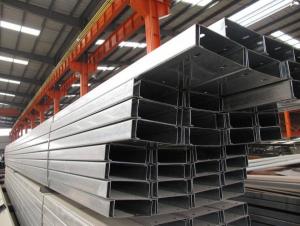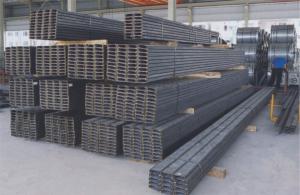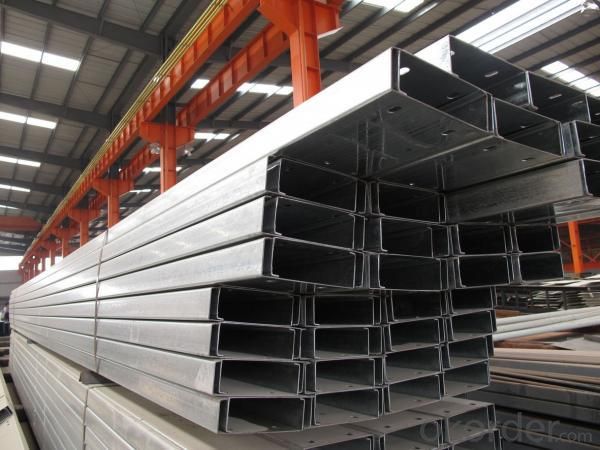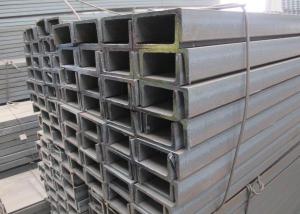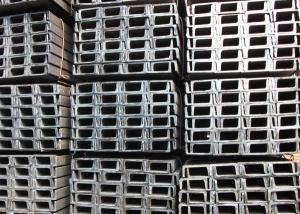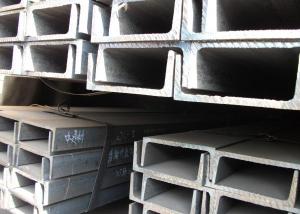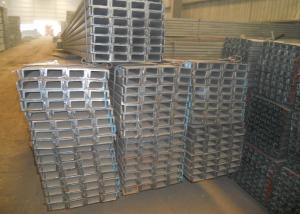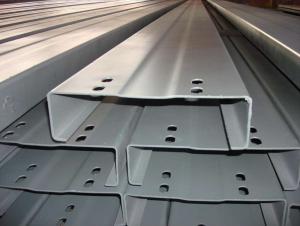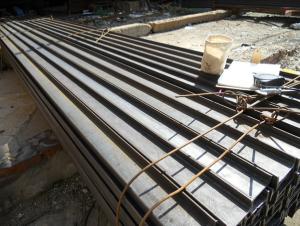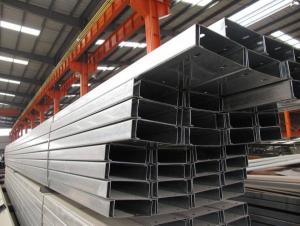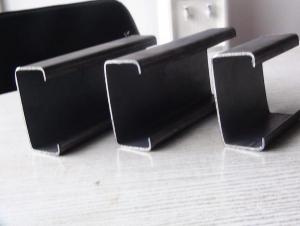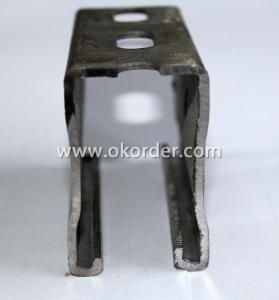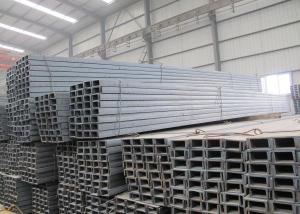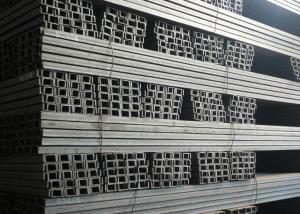CR C Channel
- Loading Port:
- Tianjin Port,China
- Payment Terms:
- TT or LC
- Min Order Qty:
- 20Tons m.t.
- Supply Capability:
- 1000 Tons Per Month m.t./month
OKorder Service Pledge
OKorder Financial Service
You Might Also Like
Specifications of CR C Channel:
1.We supply high quality CR C Channel at reasonable price, including Chinese standard, Japanese standard and so on.
Standard | GB/JIS/EN/ASTM/DIN |
Material Grade | Q235B,Q235,Q345,Q345B,SS400,S235JRG1,A36,ST37-2 |
Technique: | Cold Rolled |
Sizes as per chinese standard: |
80×40×20×2.5 - 180×60×20×2.5
|
Sizes as per Japanese standard: |
180×60×20×3 – 300×80×20×3 |
Length: | 6meter, 9meter, 12meter |
Note: we are also competent to provide our customers other CR C Channel based on other sizes according to customer’s requirements.
2. The detailed sections of CR C Channel as per GB standard.Just as followings in the table-1:
Size | Weight(kg/m) | Size | Weight(kg/m) |
80×40×20×2.5 | 3.925 | 180×60×20×3 | 8.007 |
80×40×20×3 | 4.71 | 180×70×20×2.5 | 7.065 |
100×50×20×2.5 | 4.71 | 180×70×20×3 | 8.478 |
100×50×20×3 | 5.652 | 200×50×20×2.5 | 6.673 |
120×50×20×2.5 | 5.103 | 200×50×20×3 | 8.007 |
120×50×20×3 | 6.123 | 200×60×20×2.5 | 7.065 |
120×60×20×2.5 | 5.495 | 200×60×20×3 | 8.478 |
120×60×20×3 | 6.594 | 200×70×20×2.5 | 7.458 |
120×70×20×2.5 | 5.888 | 200×70×20×3 | 8.949 |
120×70×20×3 | 7.065 | 220×60×20×2.5 | 7.4567 |
140×50×20×2.5 | 5.495 | 220×60×20×3 | 8.949 |
140×50×20×3 | 6.594 | 220×70×20×2.5 | 7.85 |
160×50×20×2.5 | 5.888 | 220×70×20×3 | 9.42 |
160×50×20×3 | 7.065 | 250×75×20×2.5 | 8.634 |
160×60×20×2.5 | 6.28 | 250×75×20×3 | 10.362 |
160×60×20×3 | 7.536 | 280×80×20×2.5 | 9.42 |
160×70×20×2.5 | 6.673 | 280×80×20×3 | 11.304 |
160×70×20×3 | 8.007 | 300×80×20×2.5 | 9.813 |
180×50×20×2.5 | 6.28 | 300×80×20×3 | 11.775 |
180×50×20×3 | 7.536 | ||
180×60×20×2.5 | 6.673 |
Table-1
3. The chemical composition of CR C Channel according to Q235B is shown in Table-2.
Alloy No | Grade | Element(%) | ||||
C | Mn | S | P | Si | ||
Q235 | B | 0.12-0.20 | 0.3-0.7 | ≦0.045 | ≦0.045 | ≦0.3 |
Table-2
Note: we are able to present our customers relevant SGS test report for chemical composition of CR C Channel.
4. The mechanical property of CR C Channel according to Q235B is shown in Table-3-1 and Table-3-2
Alloy No | Grade | Yielding Strength Point(Mpa) | |||
Thickness(mm) | |||||
≦16 | >16-40 | >40-60 | >60-100 | ||
≧ | |||||
Q235 | B | 235 | 225 | 215 | 205 |
Table-3-1
Alloy No | Grade | Tensile Strength(Mpa) | Elongation After Fracture(%) | |||
Thickness(mm) | ||||||
≦16 | >16-40 | >40-60 | >60-100 | |||
≧ | ||||||
G235 | B | 375-500 | 26 | 25 | 24 | 23 |
Table-3-2
Note: we are able to present our customers relevant SGS test report for mechanical property of CR C Channel as customer’s request.
Applications of CR C Channel:
The CR C Channel can be applied to construction of warehouses, workshops, sport stadiums and car parks etc.The hot rolled channel steel belongs to carbon structural steel which is applied to in the field of construction and machinery.In details, the hot rolled channel steel is usually used for arch-itechtural structure, and they could be welded in order to support or hang a vari-ety of facilities. They are also usually used in combination with I beam. Generally,the hot rolled channel steel we supply must possess perfect welding property, riveting property and mechanical property and so on.
Package & Delivery of CR C Channel:
1.The hot rolled channel steel will be packed in bundle with steel wire at each end of every bundle and color marking in order to help the customer to recognize his goods more easily at sight.
2. And the hot rolled channel steel could be loaded into 20ft or 40ft container, or by bulk cargo.If the weight of each bundle reaches more than 3.5 mt, the loading by break bulk cargo should be choosed.When the weight of each bundle reaches less than 3mt, the loading by container should be choosed.
3.As for the transportaion from mill to loading port, the truck will be usually used. And the maximum quantity for each truck is 40mt.
4.All in all, we could do in accordance with customer's request.
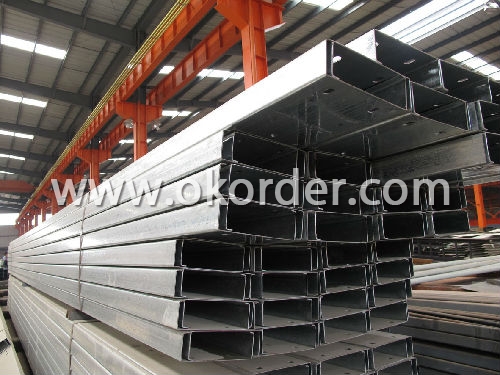
Production Flow of CR C Channel:
1.The steel billet shall be heated in the high temperature furnace.
2. The heated steel billet shall be rolled five to nine times with the aim of shaping the general figure of steel u channel.
3. The hot rolled channel steel should be put onto the cooling bed to make the temperature low.
4. The channel steel should be straighted on the straightener.
5. The straighted channel steel will be cut into meters by saw, as per customer's requirements.

- Q: How do steel channels contribute to the versatility of a building design?
- Several factors contribute to the versatility of building design when using steel channels. Firstly, the exceptional strength and durability of steel channels enable them to bear heavy loads and withstand extreme weather conditions. Architects and engineers can confidently create innovative and intricate designs, knowing that the steel channels will provide the necessary structural support. In addition, steel channels are available in various sizes and shapes, providing flexibility in design. They can be manufactured to precise specifications, allowing for customization and adaptation to suit the unique requirements of each building project. This adaptability empowers architects to construct structures with different heights, spans, and configurations, maximizing space and generating visually captivating designs. The installation and assembly of steel channels are also simplified, streamlining the construction process. They can be effortlessly connected using different methods, including welding, bolting, or riveting, ensuring efficient and cost-effective construction. This ease of installation ensures that building projects are completed promptly, saving both time and resources. Moreover, steel channels are highly recyclable, making them an environmentally responsible choice for building designs. Steel can be recycled multiple times without compromising its inherent properties, reducing the demand for new raw materials and minimizing waste. This sustainable aspect of steel channels aligns with modern environmental standards and promotes eco-conscious construction practices, further enhancing the overall versatility of building designs. To summarize, steel channels enhance the versatility of building design through their strength, durability, customization options, ease of installation, and sustainability. By incorporating steel channels into their projects, architects and engineers can push the boundaries of design, create distinctive structures, and meet the diverse needs of their clients and communities.
- Q: Are steel channels suitable for use in warehouse storage systems?
- Yes, steel channels are suitable for use in warehouse storage systems. They provide strong structural support and durability, making them ideal for storing heavy loads and maximizing storage capacity. Additionally, steel channels are versatile and can be easily customized to fit specific warehouse storage needs.
- Q: What are the common design codes and standards for steel channels?
- Steel channels must adhere to various design codes and standards to guarantee their structural integrity and safety. The most widely recognized codes and standards for steel channel design include: 1. The AISC (American Institute of Steel Construction) Steel Construction Manual provides specifications for the design, fabrication, and erection of structural steel for buildings. It offers guidelines for steel channel design, covering dimensions, loading conditions, and connection requirements. 2. The ASCE (American Society of Civil Engineers) publishes standards and guidelines for civil engineering structures, including steel channels. Their publication ASCE 7-16 Minimum Design Loads and Associated Criteria for Buildings and Other Structures specifies the loads and load combinations that steel channels should withstand. 3. The IBC (International Building Code) is a comprehensive set of building regulations adopted globally. It includes provisions for the design of steel channels and other structural elements, emphasizing safety, load resistance, and structural stability. 4. The EN (European Committee for Standardization) standards define specifications for various steel products, including channels. EN 10025-2 specifically covers hot-rolled structural steel channels, outlining their mechanical properties, dimensions, and tolerances. 5. The BSI (British Standards Institution) publishes standards for steel channels under the BS EN 10365 series. These standards address dimensions, tolerances, and technical requirements for hot-rolled steel channels used in construction. Designers, engineers, and manufacturers must comply with these codes and standards to ensure proper design, fabrication, and safe usage of steel channels in diverse structural applications. Adhering to these guidelines promotes consistency, quality, and structural integrity within the construction industry.
- Q: Are steel channels cost-effective?
- Indeed, steel channels are commonly regarded as a cost-effective option. Renowned for its durability, strength, and longevity, steel stands as a dependable substance for a multitude of construction and industrial purposes. The purpose of steel channels is to offer structural reinforcement, evenly distribute burdens, and improve steadiness in edifices and infrastructure ventures. Furthermore, steel channels are conveniently obtainable and can be effortlessly crafted to meet particular project specifications. Despite potentially higher initial expenses in comparison to alternative materials, the enduring advantages of steel, such as minimal upkeep requirements and resistance to corrosion, render it an economically sensible selection in the grand scheme of things.
- Q: Can steel channels be used in the construction of bridges?
- Steel channels are indeed applicable for bridge construction. These structural components possess remarkable strength and stiffness, rendering them an excellent choice for such projects. Notably, they are frequently employed in constructing the essential framework and supports of bridges, effectively ensuring stability and load-bearing capabilities. Furthermore, steel channels offer great versatility as they can be fabricated into various shapes and sizes, enabling flexibility in bridge design. It is worth noting that steel is highly durable and long-lasting, capable of withstanding heavy loads, adverse weather conditions, and other environmental factors. Consequently, it is a highly suitable material for bridge construction. In summary, due to their strength, versatility, and durability, steel channels are widely utilized in bridge construction.
- Q: Are steel channels suitable for architectural applications?
- Yes, steel channels are suitable for architectural applications. They provide structural support and can be used for various purposes such as framing, cladding, and creating architectural features. Steel channels offer strength, durability, and versatility, making them a popular choice in the construction industry for architectural projects.
- Q: Can steel channels be used for support columns?
- Yes, steel channels can be used for support columns. Steel channels are commonly used in construction for various structural applications, including supporting columns. They are known for their strength and durability, making them ideal for bearing heavy loads and providing structural support. Additionally, steel channels can be easily fabricated and installed, making them a popular choice for support columns in both commercial and residential buildings.
- Q: How do steel channels contribute to the stability of a structure during high winds?
- There are several ways in which steel channels contribute to the stability of a structure during high winds. To begin with, they provide support and reinforcement to the overall framework of a building. Typically used as beams or columns, steel channels are strong and rigid, effectively distributing the forces exerted by high winds throughout the structure. This prevents the building from swaying or collapsing under the intense wind pressure. Moreover, steel channels have excellent resistance to bending and torsion, enabling them to withstand the dynamic loads associated with high winds. Their robustness ensures that the structure remains intact and maintains its shape even when faced with strong gusts. Strategically positioning steel channels in critical areas of a building, such as corners or near openings, further enhances its stability during high winds. By reinforcing these vulnerable points, the channels minimize the risk of structural failure or damage. Furthermore, steel channels are often combined with other structural elements, such as braces or cross beams, to create a more rigid and stable framework. This combination of different structural components effectively increases the overall strength and resilience of the building, providing further protection against the impact of high winds. In summary, the role of steel channels in ensuring the stability of a structure during high winds is crucial. Their strength, rigidity, and ability to distribute and withstand forces contribute to the overall structural integrity, preventing the building from being compromised by strong winds and ensuring the safety of its occupants.
- Q: How do steel channels perform in high-seismic areas?
- Steel channels perform well in high-seismic areas due to their inherent strength and flexibility. The unique shape of steel channels allows them to absorb and distribute seismic forces, minimizing structural damage during earthquakes. Additionally, steel's high strength-to-weight ratio makes it an ideal material for constructing earthquake-resistant buildings and infrastructure.
- Q: Can steel channels be used in outdoor applications?
- Yes, steel channels can be used in outdoor applications. Steel channels are made from strong and durable steel material, making them resistant to harsh weather conditions such as rain, snow, and extreme temperatures. They are commonly used in outdoor structures like bridges, highways, and outdoor equipment due to their high strength and ability to withstand heavy loads. Additionally, steel channels can be treated with protective coatings such as galvanization or powder coating to further enhance their resistance to corrosion and rust, making them suitable for long-term outdoor use.
1. Manufacturer Overview
| Location | Tianjin, China |
| Year Established | 2007 |
| Annual Output Value | Above US$ 15 Million |
| Main Markets | Southeast Asia; Africa |
| Company Certifications |
2. Manufacturer Certificates
| a) Certification Name | |
| Range | |
| Reference | |
| Validity Period |
3. Manufacturer Capability
| a) Trade Capacity | |
| Nearest Port | Tianjin |
| Export Percentage | 15%-20% |
| No.of Employees in Trade Department | 11-20 People |
| Language Spoken: | English; Chinese; |
| b) Factory Information | |
| Factory Size: | Above 6,500 square meters |
| No. of Production Lines | 1 |
| Contract Manufacturing | OEM service offered |
| Product Price Range | average |
Send your message to us
CR C Channel
- Loading Port:
- Tianjin Port,China
- Payment Terms:
- TT or LC
- Min Order Qty:
- 20Tons m.t.
- Supply Capability:
- 1000 Tons Per Month m.t./month
OKorder Service Pledge
OKorder Financial Service
Similar products
Hot products
Hot Searches
Related keywords
